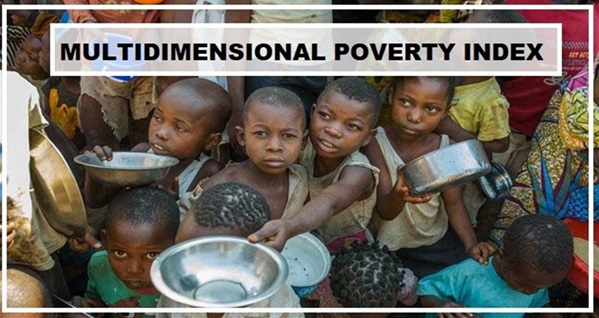
- The Multidimensional Poverty Index (MPI) is a composite measure of poverty that goes beyond income-based indicators.
- It reflects the multiple deprivations that people experience simultaneously across three core dimensions:
- Health
- Education
- Standard of Living
- Developed by the Oxford Poverty and Human Development Initiative (OPHI) in collaboration with the United Nations Development Programme (UNDP), the MPI was first launched in 2010 and is published annually as part of the Human Development Report.
- MPI aims to capture the depth and breadth of poverty, enabling policymakers to identify and target deprivations more precisely.
- It supports Sustainable Development Goal 1 (SDG-1):
“End poverty in all its forms everywhere.”
Structure of MPI
|
Dimension
|
Weight
|
Indicators
|
Weight of Indicator
|
|
Health
|
1/3
|
Nutrition
|
1/6
|
|
|
Child Mortality
|
1/6
|
|
Education
|
1/3
|
Years of Schooling
|
1/6
|
|
|
School Attendance
|
1/6
|
|
Living Standards
|
1/3
|
Cooking Fuel
|
1/18
|
|
|
Sanitation
|
1/18
|
|
|
Drinking Water
|
1/18
|
|
|
Electricity
|
1/18
|
|
|
Housing
|
1/18
|
|
|
Assets Ownership
|
1/18
|
Health
- Nutrition: Undernourishment among adults and children.
- Child Mortality: Death of children under 18 years in the family.
Education
- Years of Schooling: No household member aged 6 or older has completed at least six years of schooling.
- School Attendance: Any school-aged child is not attending school up to the age at which they would complete class eight.
Living Standards
- Cooking Fuel: Use of dung, wood, charcoal, or coal for cooking.
- Sanitation: Lack of improved sanitation facilities or shared facilities.
- Drinking Water: No access to improved drinking water or water source is more than a 30-minute walk from home.
- Electricity: No electricity in the household.
- Housing: Inadequate roofing, walls, or flooring materials.
- Assets: Lack of ownership of assets like radio, television, telephone, computer, bicycle, motorbike, or refrigerator.
Key Findings from the 2024 Global MPI Report
- The 2024 MPI report, titled “Poverty amid Conflict”, highlights the compounded challenges faced by populations in conflict-affected regions.
- Key findings include:
- Over 1.1 billion People live in multidimensional poverty across 112 countries.
- 455 million of the poor reside in countries exposed to violent conflict, experiencing more severe deprivations.
- 584 million poor individuals are children under 18 years.
- 76 countries have made significant progress in reducing poverty.
- Sub-Saharan Africa and South Asia are the most affected regions.
- Children under 18 constitute nearly half of the global MPI poor.
- Conflict and climate change continue to be key drivers of multidimensional poverty.
- The report underscores the necessity of addressing both poverty and conflict simultaneously to achieve sustainable development goals.
National Multidimensional Poverty Index (NMPI)
- Introduced by NITI Aayog in 2021.
- Uses data from the National Family Health Survey (NFHS).
- Retains the 10 global MPI indicators, and adds:
- Maternal Health
- Bank Account Ownership
- Progress
- Between 2005-06 and 2019-21, 415 million people exited multidimensional poverty in India.
- Bihar, Jharkhand, and Uttar Pradesh are among the states with high MPI but showing improvement.



